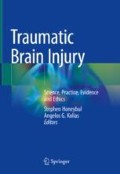Abstract
The question of long-term outcome is one that needs to be considered at all stages and severity of traumatic brain injury (TBI). In cases of mild and relatively moderate head injury, patients and their families will often be concerned regarding issues such as restoration of neurocognitive function, social reintegration, and return to work. For the more severe injuries, the initial concerns may revolve around the issues of life and death and thereafter the possibility of survival with severe disability.
However, notwithstanding the clinical value of a number of assessment tools, long-term outcome is usually dichotomized into favorable or unfavorable, the implication being that for a therapy to be considered beneficial, more patients in the intervention arm of a trial should achieve a favorable outcome, and from a research perspective, this is an entirely reasonable approach. However, for an individual patient and their families, adopting this position can be problematic.
Many patients who have had a relative mild head injury go on to make a full recovery; however, the favorable outcome category also includes patients with moderate disability, and this by definition includes patients whose work capacity is reduced and who have ongoing personality and interpersonal problems. The impact that these issues have on an individual and their families can be significant, and in certain cases, the term “favorable” may fail to adequately describe their perceived outcome. Likewise, there are certain patients who survive in the unfavorable outcome category who appear perfectly happy. The question remains as to how this should be approached from a clinical and ethical perspective such that patients and families can be counseled appropriately regarding realistic long-term outcome expectations.
Access this chapter
Tax calculation will be finalised at checkout
Purchases are for personal use only
References
Hutchinson PJ, Kolias AG, Timofeev IS, et al. Trial of decompressive craniectomy for traumatic intracranial hypertension. N Engl J Med. 2016;375:1119–30.
Lucas S, Smith BM, Temkin N, et al. Comorbidity of headache and depression after mild traumatic brain injury. Headache. 2016;56:323–30.
van der Naalt J, Timmerman ME, de Koning ME, et al. Early predictors of outcome after mild traumatic brain injury (UPFRONT): an observational cohort study. Lancet Neurol. 2017;16:532–40.
Jaeger M, Deiana G, Nash S, et al. Prognostic factors of long-term outcome in cases of severe traumatic brain injury. Ann Phys Rehabil Med. 2014;57:436–51.
Mollayeva T, Kendzerska T, Mollayeva S, et al. A systematic review of fatigue in patients with traumatic brain injury: the course, predictors and consequences. Neurosci Biobehav Rev. 2014;47:684–716.
Hicks AJ, Gould KR, Hopwood M, et al. Behaviours of concern following moderate to severe traumatic brain injury in individuals living in the community. Brain Inj. 2017;31:1312–9.
Goode D. The national quality of life for persons with disabilities project: a quality of life agenda for the United States. In: Goode D, editor. Quality of life for persons with disabilities. Cambridge: Brookline Press; 1994. p. 139–61.
Ubel PA, Loewenstein G, Schwarz N, et al. Misimagining the unimaginable: the disability paradox and health care decision making. Health Psychol. 2005;24:S57–6.
Albrecht GL, Devlieger PJ. The disability paradox: high quality of life against all odds. Soc Sci Med. 1999;48:977–88.
Albrecht GL, Higgins PC. Rehabilitation success: the interrelationships of multiple criteria. J Health Soc Behav. 1978;18:36–45.
Vahedi K, Hofmeijer J, Juettler E, et al. Early decompressive surgery in malignant infarction of the middle cerebral artery: a pooled analysis of three randomised controlled trials. Lancet Neurol. 2007;6:215–22.
Honeybul S, Ho KM, Gillett GR. Long-term outcome following decompressive craniectomy: an inconvenient truth? Curr Opin Crit Care. 2018;24:97–104.
Honeybul S, Janzen C, Kruger K, et al. Decompressive craniectomy for severe traumatic brain injury: is life worth living? J Neurosurg. 2013;119:1566–75.
Antonovsky A. The structure and properties of the sense of coherence scale. Soc Sci Med. 1993;36:725–33.
Antonovsky A. Complexity, conflict, chaos, coherence, coercion and civility. Soc Sci Med. 1993;37:969–81.
Giacino JT, Ashwal S, Childs N, et al. The minimally conscious state: definition and diagnostic criteria. Neurology. 2002;58:349–53.
Kobylarz EJ, Schiff ND. Functional imaging of severely brain-injured patients: progress, challenges, and limitations. Arch Neurol. 2004;61:1357–60.
Schiff ND, Rodriguez-Moreno D, Kamal A. fMRI reveals large-scale network activation in minimally conscious patients. Neurology. 2005;8(64):514–23.
Schiff ND, Ribary U, Moreno DR, et al. Residual cerebral activity and behavioural fragments can remain in the persistently vegetative brain. Brain. 2002;125:1210–34.
Schiff ND, Giacino JT, Kalmar K, et al. Behavioural improvements with thalamic stimulation after severe traumatic brain injury. Nature. 2007;448:600–3.
Steyerberg EW, Mushkudiani N, Perel P, et al. Predicting outcome after traumatic brain injury: development and international validation of prognostic scores based on admission characteristics. PLoS Med. 2008;5:e165.
MRC CRASH Trial Collaborators, Perel P, Arango M, et al. Predicting outcome after brain injury: practical prognostic models based on a large cohort of international patients. BMJ. 2008;23:425–9.
Honeybul S, Ho KM. Predicting long-term neurological outcomes after severe traumatic brain injury requiring decompressive craniectomy: a comparison of the CRASH and IMPACT prognostic models. Injury. 2016;47:1886–92.
Author information
Authors and Affiliations
Corresponding author
Editor information
Editors and Affiliations
Ethics declarations
None declared.
Financial support: No financial support has been required for this research.
Rights and permissions
Copyright information
© 2021 Springer Nature Switzerland AG
About this chapter
Cite this chapter
Honeybul, S. (2021). Long-Term Outcome Following Traumatic Brain Injury. In: Honeybul, S., Kolias, A.G. (eds) Traumatic Brain Injury. Springer, Cham. https://doi.org/10.1007/978-3-030-78075-3_34
Download citation
DOI: https://doi.org/10.1007/978-3-030-78075-3_34
Published:
Publisher Name: Springer, Cham
Print ISBN: 978-3-030-78074-6
Online ISBN: 978-3-030-78075-3
eBook Packages: Biomedical and Life SciencesBiomedical and Life Sciences (R0)

